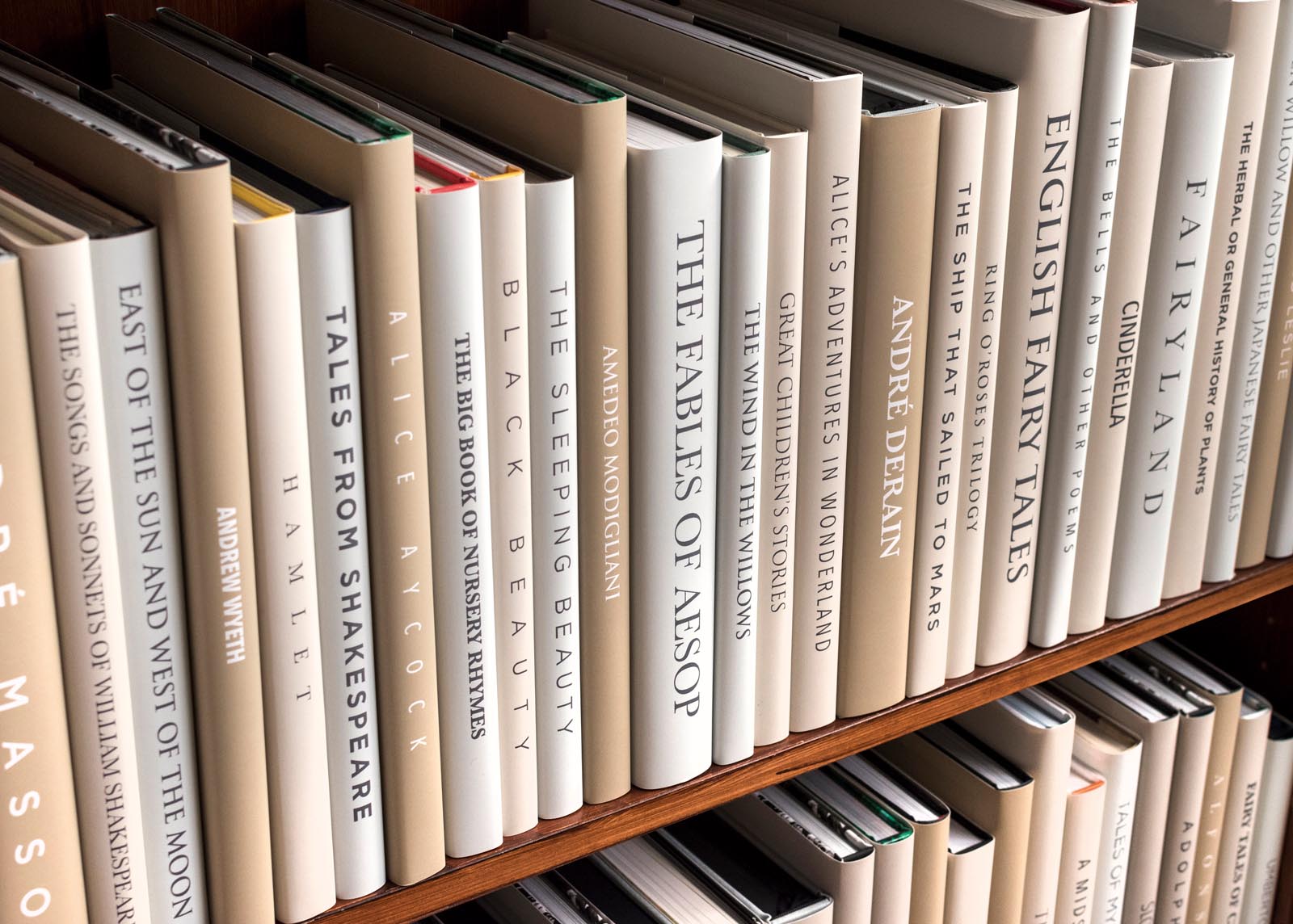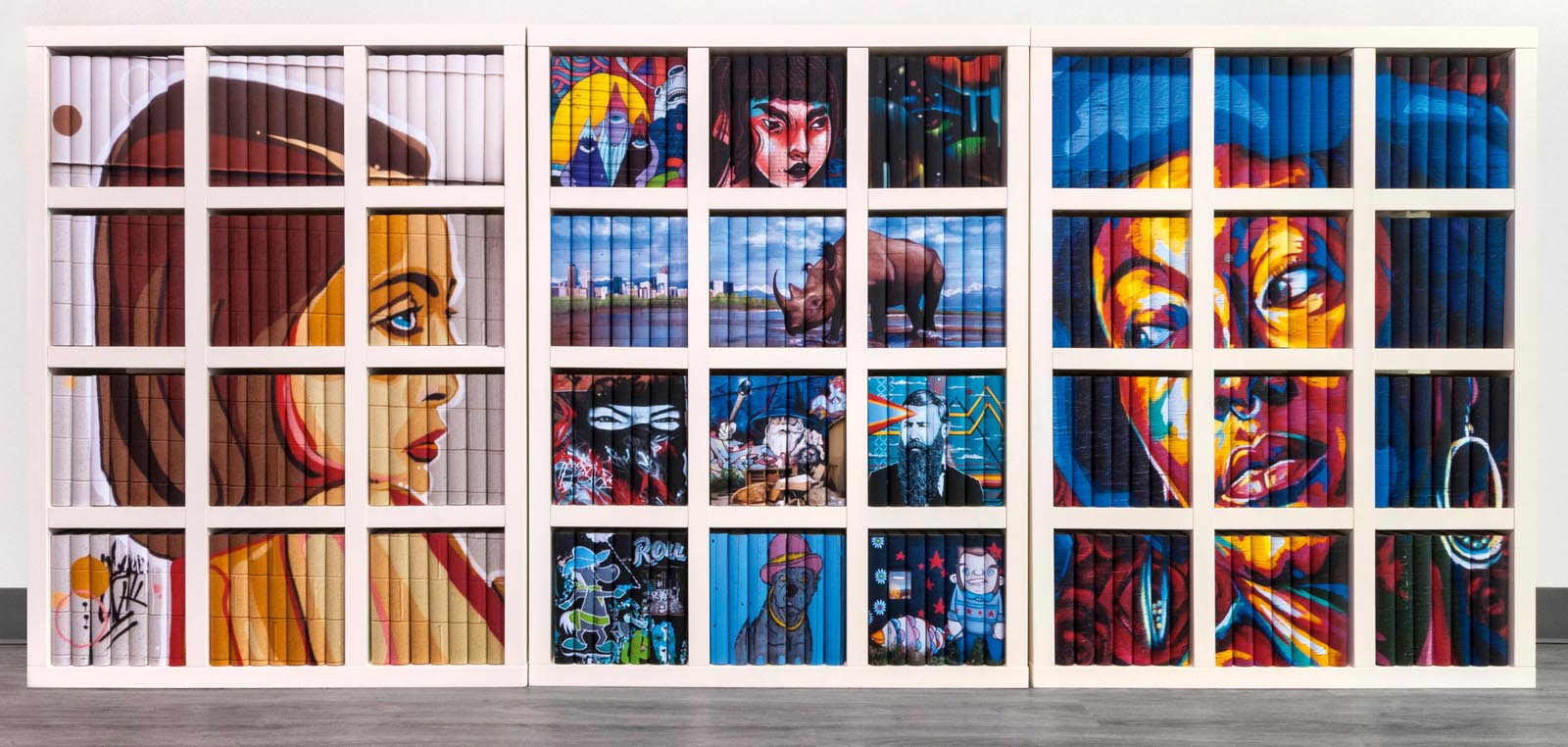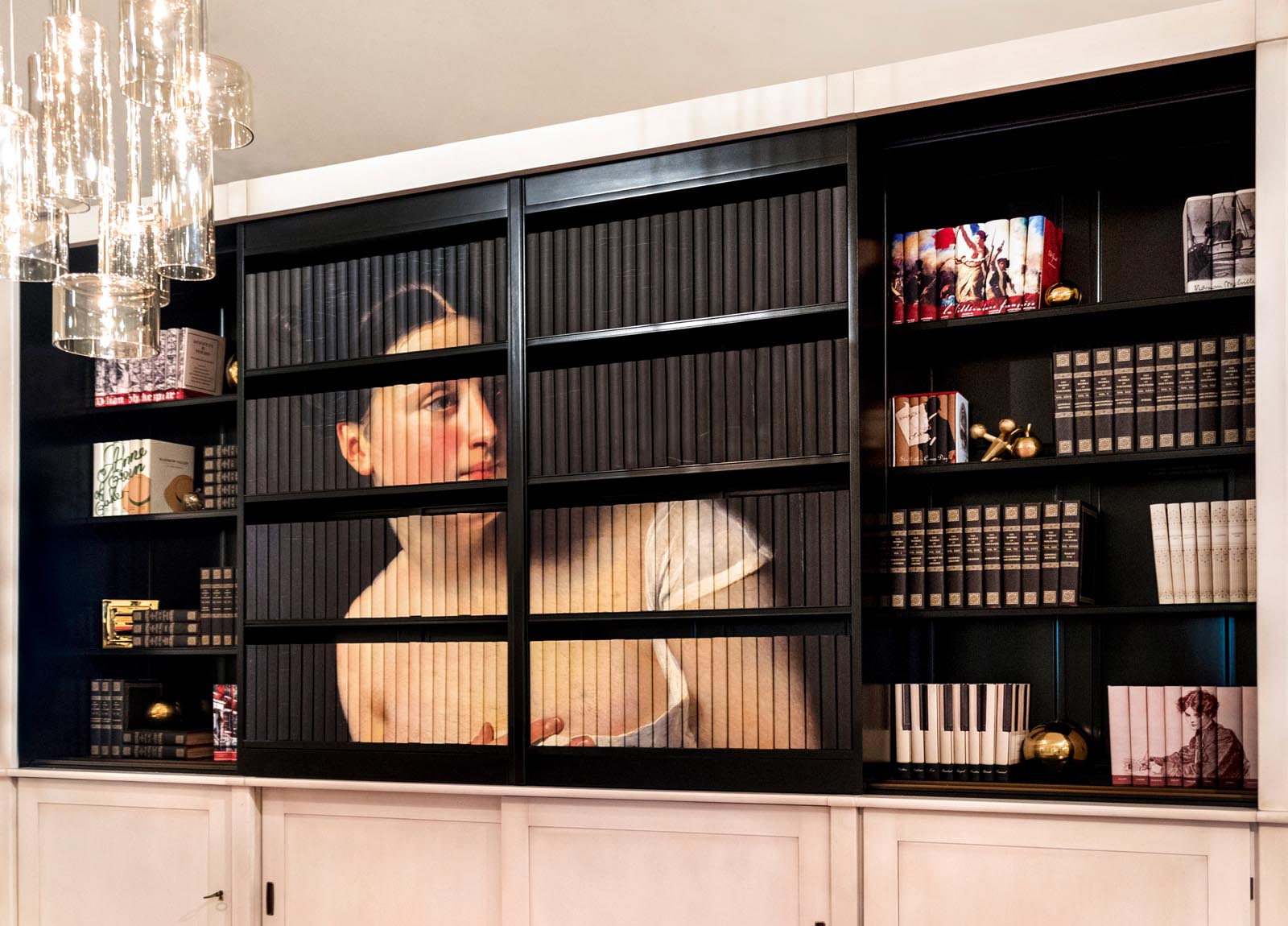
When Thatcher started selling books in 2001, he mostly sold rare books and first editions one book at a time. However, within a few years, he was getting requests to curate libraries for interior designers and homeowners.
The requests were varied—one client with a home in South Carolina wanted a highly curated collection of contemporary books on different subjects in a number of rooms. Another client wanted a library of beautiful antique leather and vellum books for their home in Westchester County, New York. A spa in Miami wanted 1,200 white books to fill their shelves, creating a very modern and clean “Miami” look.
The designer for the Miami spa was Philippe Starck. Starck has been an innovator in the world of design for decades. His firm placed several orders in short succession for these “color walls” of books—black books for a project in Dallas, gold wrapped books for one part of a project in Panama, and vibrant rainbow colors for another part of that property. It didn’t matter to these projects what the books were. The designer wanted a specific color and nice clean lines, with the spines left blank and no printed titles.

Juniper Books purchased thousands of sheets of high quality art paper to wrap the books in various colors.
Insider Advice: If you love your books and don’t want to part with them, but they don’t look quite right, consider visiting your local art or stationery store, then wrapping your books in handmade paper jackets—an upgraded take on how we used to wrap our textbooks in paper bags in middle and high school. Same idea, simply elevated.
As the blank books filled up the shelves at these client installations, Thatcher realized something. When the titles and colors of the original books melted away, what was left was a blank canvas made up of hundreds or thousands of books.
Could Juniper Books “paint” those canvases in a new way that the world had never seen before?
Thatcher had long understood the power of books to tell stories on their pages and on the shelves, but it was at that moment that he saw the true potential for artistic expression across the shelves.
Up until that point, Thatcher thought that his contribution to the world of books was to curate the best of existing books from sources all over the world. If a client wanted leather bindings, or oversize art books, or just nice clean hardcovers, he would source them and assemble them into a coherent collection. Occasionally he would work with clients on rebinding books, cultivating a network of bookbinders across the country. Because of this he knew how time consuming and expensive bookbinding was.



The epiphany about books as a canvas led to the invention of custom book jackets in 2008. The US economy was crashing, Juniper Books was seven years old, and Thatcher had a two-year-old son and a daughter on the way. It was a risky time to expand but Juniper Books moved out of the basement of Thatcher’s house and into a 1,500 square foot warehouse.
Once there, Thatcher sat down at the computer with a stack of books next to him and a few hypotheses to test out:
Could book jackets be printed in a uniform color with their titles on the spines? Thatcher knew there would be a lot of demand from clients who wanted a specific color for their library but also wanted to be able to find their books.
Could old books be transformed into new-looking books with the addition of custom jackets? Conversely, could new books be made to look like old books with the addition of antique leather–style jackets?
And lastly, could a group of books be pushed together to form a larger “canvas” on which art could be printed and displayed across the spines? If this was successful, the possibilities were endless.



Miraculously, all of these ideas worked and ten years later, Juniper Books produces hundreds of custom orders a year using each of these ideas, working with clients who want to do more with their books and their spaces, to make their bookshelves come alive, to unleash their storytelling and artistic potential.1
Quite honestly, back in 2008 when printed book sales were declining, Thatcher also wanted to give people more reasons to buy books and keep them forever! Turning them into artwork was definitely one strategy worth trying.


Taking the three ideas that Thatcher started playing with in those early years and fast-forwarding to the present day, you can see the evolution of the company’s design capabilities. Juniper Books invested substantial time and resources into determining what paper printed and folded best, how to make the jackets more durable, and what printers and other equipment to use in the process.
Viewing your books artistically and seeing your bookshelves as potential canvases for artistic expression can be a lot of fun. You can follow a similar approach that Thatcher took to the development of custom jackets as a transformative artistic medium.
The first idea from 2008 for printing custom jackets was all about color. The idea was to rapidly change the color of a whole shelf or wall of books from what the publisher had decided on for the color of the bindings or jackets to what you as the owner of the jackets really wanted. If you look at your bookshelves, how would you change the color of the books to suit your preferences?
Clients had been asking us for years to curate books with a specific color palette in mind, and white books and neutral color books were the most popular request by far.
Now the possibilities were endless and clients routinely ask Juniper Books to match a Pantone color, a carpet sample, or a paint chip. Is there a color in your home that you would match your books to if you had the chance?



The second idea that Thatcher had for custom jackets was all about changing the style of the books. In a nutshell, could we make old books look like new books and new books look like old books? Thatcher used his grandmother’s grease-stained Settlement Cook Book for one prototype, making a brand new jacket for it, giving the book new life and presence.
For another set of prototypes, Juniper Books printed leather-style jackets for autobiographies by Jay-Z and Keith Richards, turning them into instant classics that could stand next to Jane Austen and Charles Dickens.
What books would you transform in your home? Do you have old books that you’d like to make look like new? Do you have new books that you wish looked more like antique or vintage editions? Do you have a favorite binding or cover style that you’d love to get your favorite books in?
If you love Sue Grafton or John Grisham, would you want to transform them into leather-bound classics or Victorian novels perhaps? Would you like your home to look like the library in Downton Abbey, but actually filled with the page-turners you love? Would you like to take the nonfiction you own and make it into a contemporary color library?








Credit: Ursula Melhuish.

The third concept that we were playing around with at the inception of custom printed jackets was to print an image across multiple book spines. One of the first images that Thatcher experimented with was a self-portrait by Leonardo da Vinci!
Over the years, we’ve made hundreds of custom projects where we’ve printed photographs, illustrations, original artwork, or reproductions of famous paintings across jacket spines—from a handful of books to more than 1,200 volumes.
Some of these projects are purely decorative with books that are not really meant to be read. The jackets are still wrapped around real books as we feel that the weight and depth of books conveys meaning even when the books are not intended for reading.
For the projects that combine very personalized book collections with personalized artwork, the combination can be magical.


Some people think it’s superficial to make books look like anything other than the original publisher’s binding. However, we would argue that by adding your own personal touch to the books, you are really making them your own. Further, it’s a fact that you can’t read all your books at any given time. We believe that your books should look great while they are on the shelves waiting to be read.
Turning the books you love into a work of art that is one of a kind may have deeper meaning to someone, we would argue, than owning a two-dimensional work of art. This work of art can be interacted with in so many ways.
You can take the books off the shelves and read them after all, the collection becoming a work of art that possesses hundreds or thousands of hours of entertainment, knowledge, and enjoyment.
If you were to transform your shelves into a work of art, what would you do?
Is there an image that comes to mind? A famous work of art that you would recreate? Or perhaps you would use your own photography or artwork extending across a group of books?
We’ve helped customers design custom color palettes, utilize custom typefaces they developed, print pictures by their children across the spines, and so much more.
Is this concept for everyone? Probably not. The nice thing about books is that there is something for everyone and you don’t have to pick one style of books for your shelves.
“In the quiet spaces opened up by the prolonged, undistracted reading of a book, people made their own associations, drew their own inferences and analogies, fostered their own ideas. They thought deeply as they read deeply.”
—Nicholas Carr, The Shallows

Our bookshelves are artwork whether we go this extra mile or not. When we curate our book selections and choose how to present them on the shelves, they are already a work of art that reflects who we are.
We chose the books, we placed the books, we decided whether to leave them to entropy or keep them tidy.
You might think the authors wrote the books and the publishers designed the bindings, but those are individual works of creativity.
When you put the books together on personal bookshelves, the owner of those shelves is the artist. They are the storyteller.




Credit: Christine Han.
With just about anything that can be collected—money, art, property—there comes a time when people with the means and the desire start to compete with their peers to see who can put together the best and largest collection.
It was inevitable that printed books would eventually follow this path. Handwritten manuscripts and scrolls had experienced this competitive drive before—in the service of power or religion—but in eighteenth- and nineteenth-century Europe, a fervor, bordering on obsession, gripped many to put together and display a library that was better than their noble peers’.
With the emergence of tastes inherent to the romantic period of the eighteenth century, coupled with the fact that books were now readily available to a wide-reading public, there was now the desire to set one’s personal library apart from the rest, to showcase not just books, but beautiful books. As a result, book collectors began to collect leather-bound and antiquarian editions in earnest. As Charles Dickens recognizes in Oliver Twist, “There are books of which the backs and covers are by far the best parts.”2
Enter the English tradition of the gentleman’s library of the eighteenth and nineteenth centuries: wood-paneled marvels containing rows and rows of spines decorated in subtle tones of brown leather and illuminated gold-leaf lettering, the books comprising “all that well-brought up young man should know.” If you were a fan of Downton Abbey, you are familiar with this concept. Lord Grantham’s library would often steal the scene as we wondered what gems filled his shelves.
In nineteenth-century England, books were printed in softcover “wraps” then sent to the favorite binderies of each family to be bound per their instructions—preferred leather hides, colors, embellishments and decorations on each book, typefaces and title treatments, full leather, three-quarter leather, half-leather, endpapers, custom bookplates, and so on.
Most often the pages were left uncut, evidence today that the books were never read and they were just used for shelf decoration—and to make the families look smart!
What was the eighteenth and nineteenth century “gentleman” reading? Surprisingly, it’s not very different from what we are reading now. You may find a small section of fiction, larger sections then devoted to history, biography, philosophy, poetry with plays and dramas sprinkled among a selection of atlases and travel accounts. Dictionaries and encyclopedias of “universal knowledge” were also prevalent in the eighteenth century library and not just one, but a variety—something we would rarely find on our shelves today.
The way a gentleman’s library was organized is also not so different than the way we might organize our own, perhaps by subject, size, color—a system that was logical, personal, and made intuitive sense to the family. The next time you are touring a historical home—whether Edith Wharton’s home, The Mount, or residence to British royalty, Windsor Castle, linger in the libraries and among the spines and think about what story the books tell about the occupants of yesteryear.
